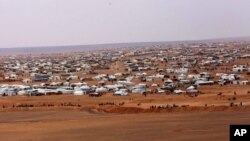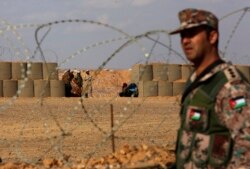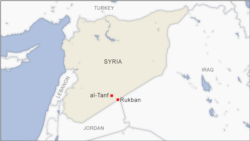As conditions deteriorate inside the Rukban Syrian refugee camp, close to the border with Jordan, thousands of people appear to be fleeing to government-controlled areas to avoid brutal desert heat and starvation.
Food supplies are critically low, and drinking water is scarce. The last United Nations food aid was reportedly delivered in February.
Syrian government TV showed a convoy of green government buses and dozens of agricultural vehicles heading toward the Jlaighem checkpoint in the city of Homs. Russian media claim over 17,000 Syrians have fled the camp for government-held territory. VOA could not independently confirm the report.
Rukban is sandwiched between Jordan, which has refused to allow the refugees to enter the country, and Syrian government-held territory that many have fled for political reasons. Jordan doesn't want refugees due to overcrowding at the camps it runs and fear that a percentage of the camp's residents are affiliated with terrorist groups. Jordan closed its border to Syrian refugees in 2014.
Syrian government media claim that the U.S., which runs the nearby al-Tanf camp alongside the Syrian border — close to both Iraq and Jordan — has been "holding residents of the camp hostage." U.S.-trained Syrian militia fighters control parts of the border, ostensibly to prevent pro-Iranian forces from gaining a foothold in the area.
No-fly zone
Hilal Khashan, who teaches political science at the American University of Beirut, told VOA that "the situation of refugees in Rukban is much like that of those in Lebanon." He said "many sympathize with rebel groups, and some of the men are likely to face a gruesome ordeal if they return to the government side."
Joshua Landis, who heads the Department of International and Area Studies at the University of Oklahoma, told VOA that the "Rukban camp has been a problem for years, with 50,000 people stuck in the middle of the desert."
He said the Syrian government "originally refused to provide food and other supplies to the refugees there because it fell within an American no-fly zone and housed families of rebel fighters who were being trained and paid for by the U.S. to fight the Syrian government."
Landis went on to say that the Syrian government's attitude toward Rukban was, "If you're going to pay terrorists to kill us, you can feed their families." He added that the U.S., for its part, "wanted no part of feeding the refugees ... because Washington understood it would be on the hook forever for food, medical care and schooling."
"Rukban," he added, "symbolizes everything that can go wrong with no-fly zones."
'Going to bed hungry'
The Syrian government news agency SANA reported that many of those returning to government-held territory were "women, children and old people." Young men who have decided to return to government-controlled areas from other regions face conscription and are periodically arrested.
A middle-aged man wearing a turban claimed the situation inside the camp was "so bad that it is impossible to describe." He said that the "bakery has only enough flour left to operate two hours a day and that food and bread supplies are rapidly being exhausted."
A young woman with a child also claimed that "people are drinking dirty water."
Another man with leathery skin claimed in an interview with Syrian TV that his children were "going to bed hungry two or three days a week."
The Washington Post reported Wednesday that the U.S.-run camp at al-Tanf is refusing to send food aid to hungry residents inside the camp and that some residents were pleading on social media for the U.S. to help.
'Demilitarized zone'
The Rukban camp, which is 55 kilometers from al-Tanf, was designated a "demilitarized zone" in a joint U.S.-Russian agreement last year. Russian media quoted Col. Gen. Mikhail Mizintsev, who heads Moscow's National Defense Control Center, as saying that "the Syrian government is ensuring safe and dignified resettlement of civilians."
Mizintsev also claims that "2 million Syrians have returned home," and that many of them have come from Jordan and Lebanon. Turkey began forcibly repatriating Syrian refugees in recent days, as well.
Some media reports claim that close to 11 million Syrians were forced to leave their homes for other parts of the country and abroad since the outset of the country's more than eight-year-old civil war. Syria had a pre-war population of around 23 million people.
Interviews with residents of the Rukban camp in both Arab and Syrian government media indicate that they come from a wide swath of the country, including Raqqa, Deir el-Zour, Palmyra and Homs.








